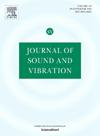Generalized difference mode decomposition for adaptively extracting fault components of rotating machinery under non-stationary conditions
IF 4.3
2区 工程技术
Q1 ACOUSTICS
引用次数: 0
Abstract
Compared with existing adaptive signal decomposition methods, difference mode decomposition can effectively extract repeated transient signal components caused by rotating machinery faults. It assumes that signal components are separable in the frequency domain while there is a frequency aliasing phenomenon among signal components under non-stationary conditions in practice. Therefore, adaptive extraction of fault components from original vibration signals under non-stationary conditions is still a challenging topic in signal decomposition fields. In this paper, a novel adaptive signal decomposition method called generalized difference mode decomposition (GDMD) is proposed as an extended version of difference mode decomposition. Firstly, the proposed GDMD method transforms non-stationary signals in the time domain into stationary signals in the angular domain by using the resampling technique. Secondly, a physically explainable optimal difference spectrum is obtained to make a distinction between health signals and fault signals based on convex optimization. Besides, positive and negative thresholds of the optimal difference spectrum are automatically determined through change-point analysis. Finally, signal components are reconstructed by utilizing the inverse fast Fourier transform according to the two thresholds. The experimental research on the inner and outer race faults of rolling bearings has demonstrated the effectiveness of the proposed GDMD method in feature extraction and fault diagnosis under non-stationary conditions.
基于广义差分模态分解的旋转机械非平稳故障分量自适应提取
与现有的自适应信号分解方法相比,差分模态分解可以有效地提取旋转机械故障引起的重复暂态信号分量。假设信号分量在频域中是可分离的,但在实际应用中,在非平稳条件下,信号分量之间存在混叠现象。因此,从非平稳条件下的原始振动信号中自适应提取故障分量仍然是信号分解领域的一个具有挑战性的课题。本文提出了一种新的自适应信号分解方法——广义差模分解(GDMD),作为差模分解的扩展。该方法首先利用重采样技术将时域非平稳信号转换为角域平稳信号。其次,基于凸优化,得到了一个物理上可解释的最优差谱,用于区分健康信号和故障信号;通过变化点分析,自动确定最优差谱的正负阈值。最后,根据两个阈值利用快速傅里叶反变换重构信号分量。通过对滚动轴承内外圈故障的实验研究,验证了该方法在非平稳条件下的特征提取和故障诊断的有效性。
本文章由计算机程序翻译,如有差异,请以英文原文为准。
求助全文
约1分钟内获得全文
求助全文
来源期刊

Journal of Sound and Vibration
工程技术-工程:机械
CiteScore
9.10
自引率
10.60%
发文量
551
审稿时长
69 days
期刊介绍:
The Journal of Sound and Vibration (JSV) is an independent journal devoted to the prompt publication of original papers, both theoretical and experimental, that provide new information on any aspect of sound or vibration. There is an emphasis on fundamental work that has potential for practical application.
JSV was founded and operates on the premise that the subject of sound and vibration requires a journal that publishes papers of a high technical standard across the various subdisciplines, thus facilitating awareness of techniques and discoveries in one area that may be applicable in others.
 求助内容:
求助内容: 应助结果提醒方式:
应助结果提醒方式:


